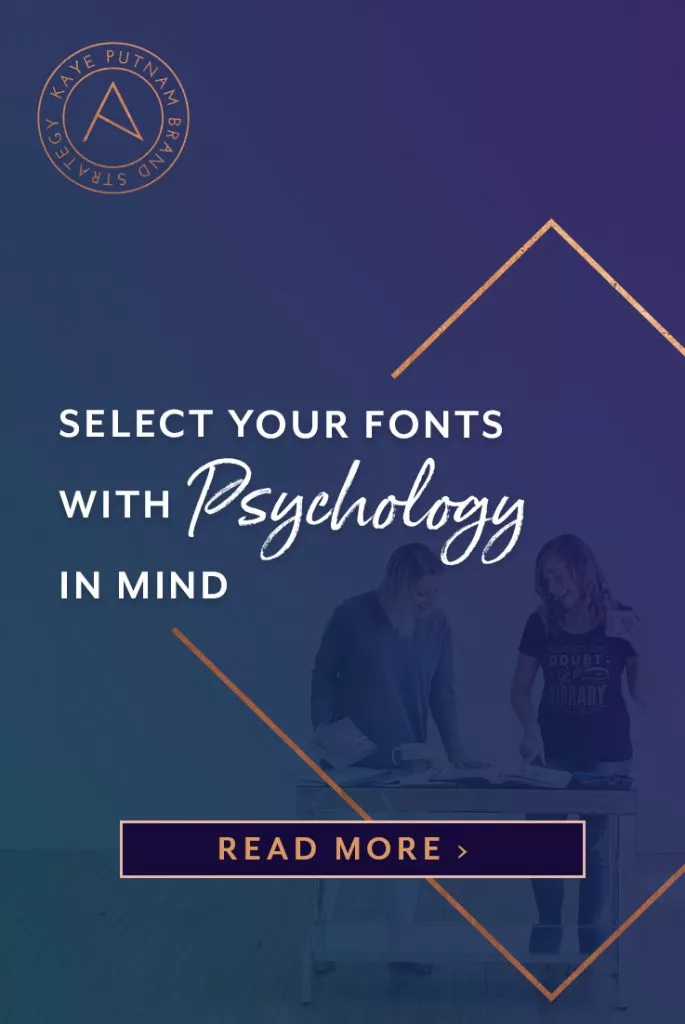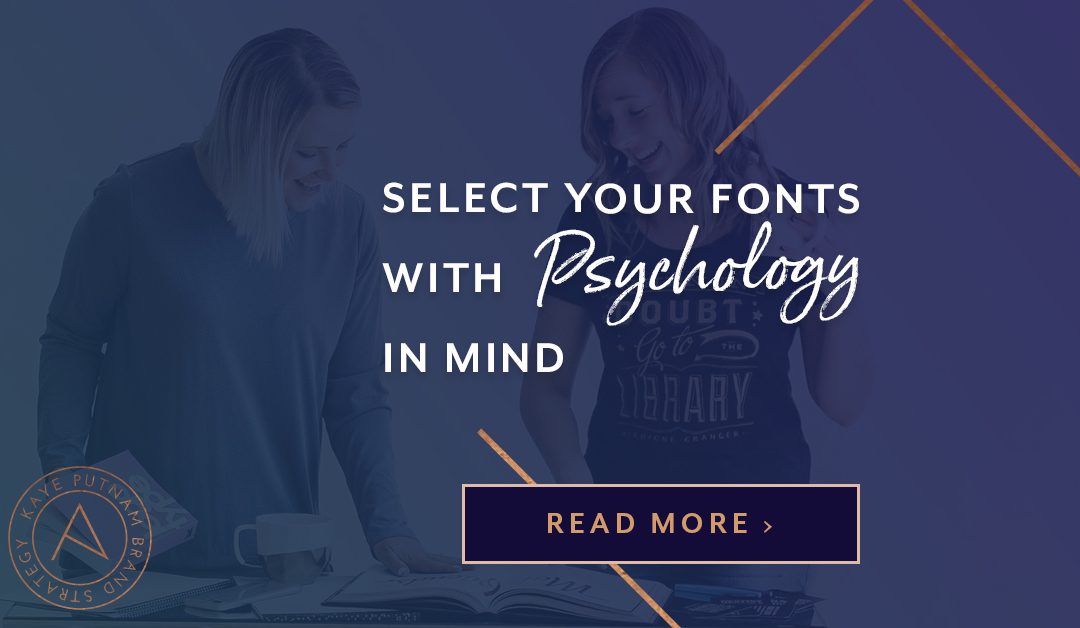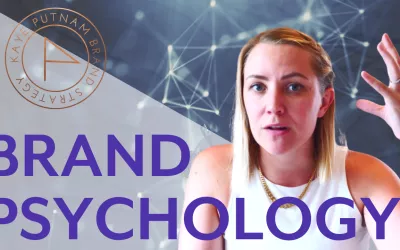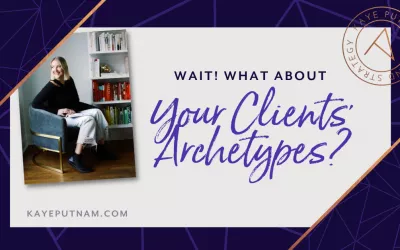Ahh, the psychology of fonts…
If you hang out here because you are a brand nerd like me 🤓, then this phrase probably gets you PRET-ty excited.
Maybe you have visions of serifs dancing in your head…
Maybe you don’t (Ummmm, what’s a serif?), but you’d like some help identifying fonts that are a fit for your brand.
Either way, settle in for some geeky fun, because in this article I’m diving deep into the psychology of your typography.
I’m outlining the three different types 😉 of fonts (See what I did there? 🤣) – and giving you tips about where and how to use them. After reading, you’ll be able to make more educated and intentional font selections for your brand.
🎥 If you prefer a video lesson on the subject from yours truly 😉 … click to watch. If you want to read the article, carry on! (Pssst… I’ve heard the biggest branding nerds do both!)
Humans are wired to look for patterns.
To understand why certain fonts tend to prompt certain emotions, thoughts, and responses, it’s important to examine how humans perceive stuff. Over time, our brains gather data and organize it. Through our experiences, our consumption of media, our formal and informal education… and more… we are constantly processing and organizing information.
Numerous psychological studies – across many disciplines – have shown that our brains are wired to look for patterns. ⬅️
In one seminal 2014 paper on Superior Pattern Processing (SPP), Mark T. Mattson writes:
“The fundamental function of brains… is to encode and integrate information acquired from the environment through sensory inputs, and then generate adaptive behavioral responses.”
In other words, we look to make associations with what we’re seeing – and connect it to what we’ve seen in the past. (The ability to do this was critical to the survival of our Neanderthal ancestors. It helped them to identify what plants were safe to eat, how to hunt successfully, how to predict weather, and more…)
So it’s now it’s part of our DNA to look for patterns, and this tendency is powerful.
The marketing lesson here? Associations are built over time in our minds – and you can tap into some of them to send signals to people about your brand.
Your customers and clients have been seeing fonts all their lives… on newspapers, on signs, in books, on product packaging… literally everywhere. Based on the context in which they see them, they have some preconceived ideas about them.
If you choose your fonts based on the psychological narrative that’s already present, how you want people to feel, and what you want them to understand about your brand, your selections will trigger the responses of your choosing.
Pretty powerful, right? (I know you will use your new-found power for good – not evil. 😉 )
So, let’s go into the three types of typography – and the associations they bring.
(Note that, in each category, I’m giving a nod to some of the brand archetypes that are often well-aligned with each font type. These are very loose correlations. You are not obliged to use the ones that are often associated with your type! In fact, some of the most interesting and compelling brands are an artful blend of two archetypes – and incorporate intentional, yet unexpected, elements!
If you are interested in uncovering Y-O-U-R archetypes, you can take my free Brand Personality Quiz!)
Psssst… You can pin 📌 this article for reference!

Serif Fonts
Serif fonts have small extra strokes (called serifs!) at the end of each main vertical and horizontal stroke.
In his book The Origin of the Serif, Edward Catich explained that serifs were first used by stonemasons who were carving letters into stone. Outlines were painted as a guide for their work. The stonemasons would then follow the painted marks, and the paint would flare into the ends of their letter strokes.
(Sorry… I warned you we were nerding out here… 🤣)
You’ll find serif fonts in most books. They also grace the covers of some of our culture’s most venerable newspapers and magazines (like Vogue and The New York Times). You’ll also see them on signs and logos for many great institutions (like banks, museums, and universities).
Traditionally ;), brands that are well-established and timeless have used them. For that reason, we can get a few different associations from serif fonts. They feel very classic, stylish, reliable, traditional and sometimes even formal.
Widely-available serif fonts include Times New Roman, Georgia, Palatino, Garamond, and Abril Display.
Here are some of the associations people are likely to make if you’re using a serif font as your primary brand font:
- Your brand is established and has staying power.
- You value tradition.
- You are credible and knowledgeable.
- People can trust you – no matter what. You’re reliable and a known-quantity.
- Your product or service is worth the reassuringly-high prices that you charge!
The brand archetypes that serif fonts often align with? Royals, Sages, Lovers… these might work for you!
Sans-Serif Fonts
The second major category is the sans serif. And… You guessed it! …Since “sans” means “without,” these typefaces do not have the little extra strokes or flares on the ends.
In everyday life, you’ll see these fonts on highway signs (where readability is key!), in logos of more cutting edge brands, and on the covers of more contemporary magazines.
You’ll also often see sans serif fonts online and on websites. For that reason alone, they feel more modern to us. They also tend to feel more casual and youthful.
Common examples of sans serif fonts are Arial, Montserrat, Proxima Nova, and Open Sans.
One of the best things about these fonts are that they’re very versatile. You can pair them with other fonts that have more of an expressive personality to give them more balance.
Here are some of the associations people are likely to make if you’re using a serif font as your primary brand font:
- Your brand is fresh, contemporary.
- You’re no-nonsense.
- You’re on top of the latest innovations – and maybe even ahead of the curve.
- You’re straight-forward, direct, and practical.
Innocents, Mavericks, Heroes… Sans serif fonts might be great choices for you.
Script Fonts
The third major category of font is the script font – or the handwritten fonts.
Some of our favorite brands use scripts fonts – and are quite recognizable because of that choice! Kellogg’s cereal, Instagram, Coca-Cola, Virgin Airlines… their logos all feature script fonts.
These tend to be more casual and feel welcoming. Sometimes they’re more friendly and even more feminine – but that’s not always the case. (For example, a graffiti-style script font will elicit different emotions than a script that looks like it was written on a love letter – or by a child.)
Some script fonts you may know include: Playfair Script, Allura, Pacifico, and Mr. Defoe.***
⚠️ ***WARNING: Because script and hand-written fonts are so distinctive and recognizable, the usual suspects (like those above) can start to look pretty over-used and pedestrian.
If you really want to select a script font, you might need to go hunting for something that’s fresh (and legible). Tread carefully, lest you end up a cliche! ⚠️… (Just ask Ryan Gosling and the cast of Saturday Night Live… 🤣🤣🤣 … I can’t stop laughing.)
If our sans-serifs are the versatile ones, then our scripts are sort of the opposite! They’re like the skill players. They are explosive and impactful – but they need to be used extremely sparingly, for a couple of key reasons:
They can be quite loud, psychologically. They tell us a lot because they carry with them a lot of extra context.
They’re not usually very readable, so they don’t lend themselves well to long headlines, and they definitely can’t be used for body paragraphs.
In general, script fonts work well as an addition to your main fonts. They’re great for adding flare or emphasis – and to give your brand a very distinctive flavor and some interest.
Hand-written and script fonts can work as accents for many of the archetypes… but Lovers, Caregivers, Mavericks, and Creators? These might be especially aligned for you.
Okay, so that’s it. That’s my font article. Three types of fonts…
BUT, WAIT! Psyche!
I am throwing in a BONUS category – just for Y-O-U. 🙂 Here you go…
Decorative or “Display” Fonts
It’s true – most branding scholars will say there are three types of typography…
But there are some fonts that are just so distinct or unique that they don’t reeeeeaaaallly fall into one of the three buckets we’ve outlined above.
These are the ones that are just… well…kind of weird. (And we like weird around here, so we want to acknowledge them!)
These are the ones that look very decorative. You know the ones… I’ve seen some that evoke the old west – or incorporate flowers right into the letters. Similarly to script fonts, they should be used very sparingly – but they can be an effective way to infuse a big dose of personality to your brand.
⚠️ Display fonts come along with a little more baggage though, so I must offer you another caveat here. ⚠️ They tend to be quite trendy – which means they can go out of style relatively quickly.
It’s an important lesson I teach clients and students… We want to base your brand on truth, not trends.
By defining and leaning into the truth about who you are and how you show up in the world, you can build a brand that will stand the test of time. (And you won’t have to re-brand every six months!)
Because we value timelessness, we don’t want to do anything that’s too trendy in the primary expression of your brand. If you use display or decorative fonts at all, my suggestion is to incorporate them for a campaign or a specific product that you’re releasing now – for a finite period.
If you want your main brand assets to serve you for many years, stick to the serif fonts, the sans serif fonts, and the script fonts for anything that’s going to be central to your brand.
Adding Dimension
Once you’ve selected candidates for your main brand fonts, keep in mind that you can add dimension and variation through styles, too. And, these style choices will convey different things as well.
A very bold font – or a basic font in bold – will feel very strong and sturdy. Meanwhile, a very skinny, dainty font will feel more airy, modern, and light.
Fonts that are very squished together and condensed (Nerd alert: 🤓 The term for the space in between letters or characters is called kerning!) can feel very frantic and high-energy. Whereas typography that is very spread out will have a more luxurious feel – a more relaxed, confident feel.
If you use the ALL CAPS version of your fonts in your main paragraphs, it can feel like you’re shouting at people. 🙉 But when used for headlines, capitalization feels strong and assertive. Plus, sometimes – depending on the font that you’re using – the all-caps can just look more clean – almost blending into the background. So, if you have a lot of other loud design elements, choosing all caps might be a nice way to look clean or a bit streamlined.
A trend I’ve been seeing of late is to use all lowercase in text – especially in headlines or logos. While it’s a little fad-ish (and you know how I feel about THAT! 😐), it does add a playful, unexpected feel. Or, it can subtly convey that you’re not following the rules. (Might be perfect for an Innocent-Maverick archetype blend!)
Fonts are fun. (Weeeeee!) And, there’s a lot more to them than just 26 letters and some symbols! Keying into the feelings they convey – and the ideas they stand for in the minds of your customers? Pretty genius. 🤓
Whether you’re totally geeking out alongside me – or you’re new to the language and personality of typography – I hope this article gave you some new insights into the psychology behind how we use fonts in our brands.
Comment below… Do you have favorite fonts? Have you selected them for your brand? I would love to see what you have selected – and hear why you selected them.





My comment will be always the same.
I appreciate your posts very much.
You are a genius, work really hard and I wish you the best.
I hope that you shine and shine!!
I’ve read lots about the psychology of colour, but never once considered the psychology of fonts. It’s always been an unconscious selection
Love this post!
Comic Sans MS for the win forever and ever. It’s instantly recognizable to anybody who’s ever read a comic book (or anybody who happens to be a font geek…) and although it may come across as a liiiiittle dorky to some… I’m a Certified Geek Therapist (yep, that’s actually a thing!) so it UTTERLY fits into my branding!